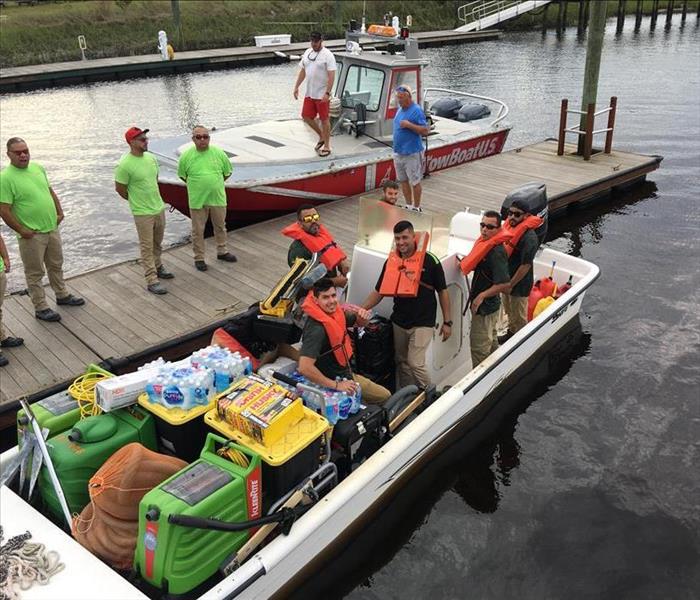What Do You Do After Storm Damage?
4/12/2020 (Permalink)
 SERVPRO Provides Stormwater Removal and Restoration Services for Miami Homes and Much More--We Are Here to Help!
SERVPRO Provides Stormwater Removal and Restoration Services for Miami Homes and Much More--We Are Here to Help!
SERVPRO has the experience and equipment to restore your Miami home and make it safe again
This part of Florida sees its fair share of intense weather systems, including tornadoes and hurricanes. The result is that homeowners can wind up with damaged roofing that allows rain inside or other structural issues from wind and water-soaked interiors from flash floods.
What are Some of the First Actions After Storm Damage Happens?
After flash floods or other types of storm damage occur in a Miami home, one of the first things a homeowner should do is to ensure the safety of the residents in the house, including pets. Common issues after storm loss include:
- Sagging ceilings from water damage
- Water wicked into sheetrock
- Floodwater tainted with sewage or chemicals
- Slip and fall accidents
- Damaged roofing and windows
What Actions Do SERVPRO Techs Perform Against Storm Loss?
When the certified technicians arrive on-site to clean up the water damage in a Miami home, they perform multiple tasks to assist in securing the property as needed, including temporary repairs. High winds can leave behind a roof that leaks. The techs have experience in doing putting up a tarp and other interim measures to inhibit any further water damage within the home.
Scoping the property is also vital. Much of the water that entered the property during a flash flood can also recede rapidly. The issue is the water that gets left behind and runs behind baseboards and wicks within the sheetrock. At a glance, it is difficult to determine the exact migration path for water solely through visual inspection. That is why the technicians use multiple types of water detection equipment to ensure that water loss in the home gets wholly addressed.
What is the Best Way to Remove Floodwater from My Home?
When the water in your Miami home is the result of a roof leak or a window break and is not groundwater, you can use towels to blot and mop up as much as you can before the arrival of SERVPRO. Wet/dry vacuums are also useful but generally do not have the pulling power to extract embedded moisture or assist when water seeps into the subfloor.
If groundwater is the culprit in your home, you need to steer clear of coming into contact with the water until SERVPRO techs arrive. It is fine to put down towels or rags to blot up water but do not come into contact with it. The techs can test the water and determine the nature of any contaminants and choose the proper methods of disinfection. If there are sewage or harmful elements present, putting up containment to prevent airborne water vapor from spreading to other areas of the home is a common tactic.
Water Type and Age Counts Towards Loss
The moment the water entered the home via rain or groundwater, it began to age. The longer structural elements of the house have exposure to moisture, the more damage that occurs.
- Paint on walls can blister and bubble
- Tile and glue-down carpet can delaminate
- Sheetrock may show signs of buckling
- Hardwood floorboards can warp and cup
- Anything saturated by groundwater requires disposal as a biohazard
- After 48 hours even rainwater gets handled as a black water event
Strong Water Removal Methods Play a Key Role
SERVPRO techs bring all the equipment necessary for water loss mitigation in their green service vans. This includes generators in case the power is out from intense storms or turned off due to the potential for water to come into contact with electrical outlets.
They use a wide range of extraction equipment, depending on the amount and depth of the water they need to remove. Each Miami home water removal is different, and while one job needs multiple portable pumps, another may require the extreme pumping services of a truck-mounted unit; this is particularly useful after a hurricane or storm surge situation.
Controlled Demolition is a Large Part of Storm Damage Cleanup
If the techs find water wicked into sheetrock, if the sheetrock has drying potential, they can drill weep holes and dry the area. More often, a tactic known as flood cuts gets applied. The techs measure above the highest waterline and cut away the damaged portion. This opens up the walls and framework for complete extraction and drying.
Carpet that absorbed groundwater or water that degraded over 48 hours is generally a loss and requires removal and disposal as a biohazard. Hardwood flooring may have restoration potential on a case by case basis depending on the length of water exposure and construction materials used for the floorboards.
When storm damage happens, call SERVPRO of South Miami at (305) 269-8900, the certified technicians are available 24/7 to restore your home to its preloss condition.



 24/7 Emergency Service
24/7 Emergency Service